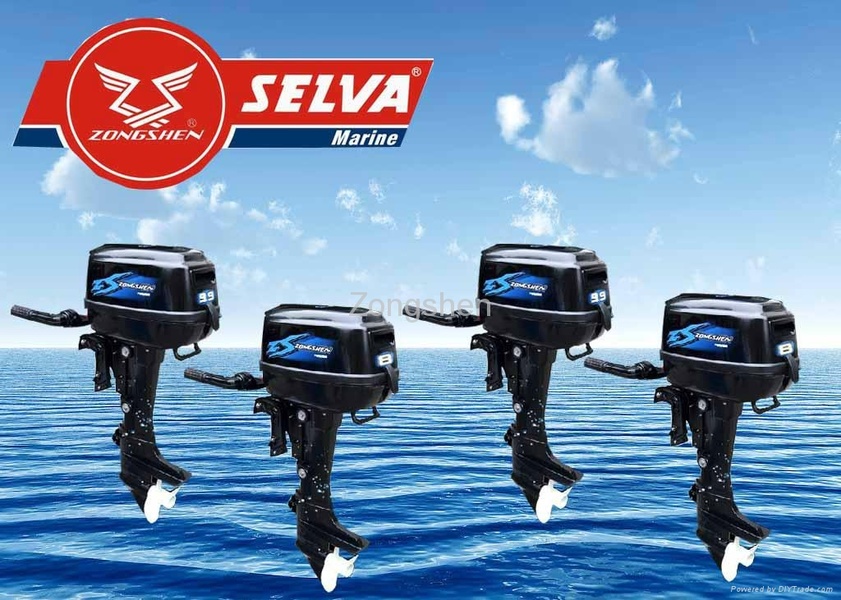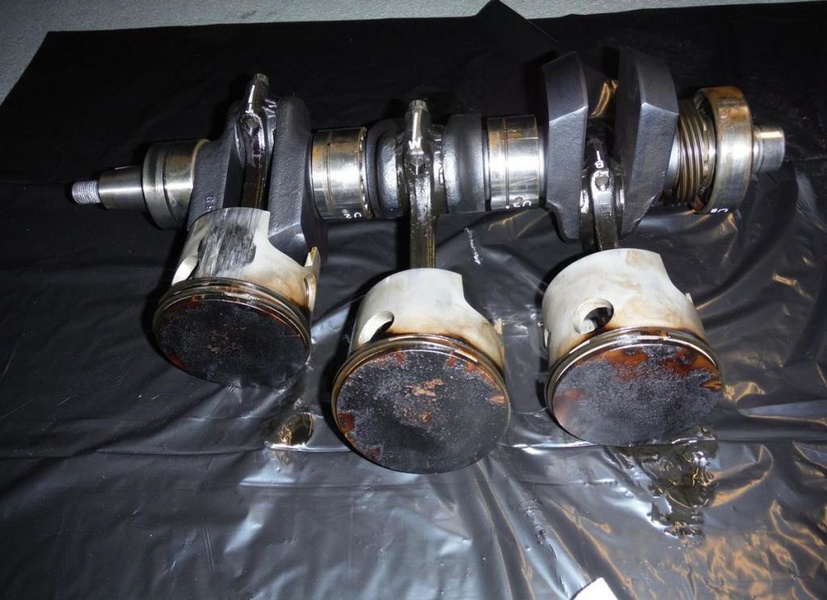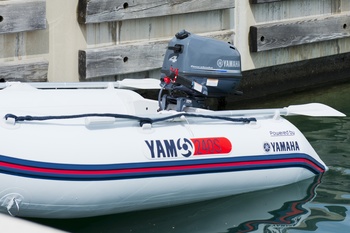In the period from 2004 to 2008, the Chinese outboard boat motor (PLM) actively entered the Russian market. The great variety of brands (more than 40 names!) are copies of Japanese motors, collected badly, and sometimes worse than just bad. Attention, the question: who buys them and why? But they buy, and a lot. Obviously, if there were no active demand, there wouldn't be such a wide supply.
The main factor is, of course, the price. The cost, RELIABLE FOR 30-50% compared to the original, is a clear motive for those to whom the difference of 30-40 thousand rubles is very critical.
But there are also those who save money by planning to use the boat infrequently: «I go out several times a season. Why overpay?»
When you save on quality, it is important, firstly, not to pay twice, and secondly, to understand clearly what exactly the savings will affect. On large and complex water bodies, motor failure can cause an emergency accident. What price are you ready to pay? In some parts of the Volga, left without a motor, you can't get to the shore on oars, and on the spills of Astrakhan can even take to the sea. Choosing an engine, in which you are not sure, you will approach with all responsibility to calculate the risks and consequences.
Market: producers and brands
For the most part, Chinese PLMs are copies of the Japanese manufacturer Yamaha. There are also Chinese versions of Tohatsu and Suzuki engines.
It is necessary to specify at once about the Korean motors: they do not exist. There are companies registered in Korea, with production all in the same China, as, for example, Mikatsu. Many companies just order motors, glue the logo of their brand on them and sell them. In fact, anyone can order a carload of motors, put «Petrov Motors» on it, and send it for sale. The main thing is not to confuse such a product with original brands that have successfully transferred their production to China. This brand is, for example, the American Mercury. If in the first years of production they had a batch of marriage, at the moment there is a minimum of complaints. However, copies of Mercury have not yet appeared on the market.
Nevertheless, even among Chinese manufacturers there are full-fledged factories which work under the bought, instead of stolen licenses, pay attention to quality of assemblage, rules, standards and try to keep the client.

China's most established manufacturer of PLM is Parsun Power Machine, which produces motors under the HDX, Parsun and Golfstream brands. The largest factory in China has more than 200 models of various modifications. In the Russian market the brands are represented since 2006 by two-stroke engines from 2 hp to 90 hp and four-stroke engines from 2.6 hp to 60 hp.
Paid licenses and imported equipment also affect pricing. The plant's products are one of the most expensive Chinese imports on the Russian market. Range HDX even claims to Russian exclusivity: the manufacturer assures that it is designed specifically for the harsh climatic conditions of our country.
However, the Parsun engines have one significant disadvantage: spare parts for them are almost impossible to find. The same problem is with Sail motors, which also claim to have more or less quality assembly.
This is the pain of all the «Chinese»: spare parts are either in short supply, or made so crooked that it is not always possible to put them in the right place.
«The lucky» owners of such motors, finding out from which «Japanese» made their unit, go looking for the originals. As a rule, these are models that have already been taken out of production, so it is not easy to find details for them. Okay, if after all the agony the original part will stand on the Chinese counterfeit. And not every service will take on this kind of work. As a result, the cost of full service of the Chinese PLM is often an order of magnitude higher than that of the Japanese original, not counting the lost time, nerves and good days for fishing.
The so-called middle segment - Sea Pro engines of Zhejiang Pioneer Machinery & Electron are not the worst copies of Yamaha. Their cost is an order of magnitude lower than the brands of Parsun factory, and the situation with spare parts is better. True, Sea Pro engines often break down. Dealers, as a rule, provide a warranty and often have their own service.

Zongshen-Selva - a copy of the Italian Selva. It appeared immediately after the official ban on two-stroke engines in Europe. The original Italian-made Selva in itself was not the best representative of its class, and the Chinese copy leaves much to be desired.
It is not clear what miracle to count on when buying quite cheap Chinese motors.
One example of a budget «Chinese» is a Breeze engine. Breeze is a copy of the same Japanese original as Golfstream, but costs half as much. Ask yourself the question: why is it possible to reduce the cost of one and the same engine so much? Given that the more expensive version is far from the original?
Hangkai, Hidea and Mikatsu have a lot of complaints about them. Yamabisi generally breaks records, returning eight out of ten engines with marriage. Did you dig up a good review among hundreds of complaints? Well, the lottery is lucky sometimes, too!
It is also necessary to take into account the following point: when starting production, companies usually put a lot of original parts. Hidea, bought five years ago, had a chance to depart its resource with fewer complaints than now.
What kind of problems can you face

The biggest problem with all Chinese engines is the quality of material and very poor assembly. And the key word here is economy.
Basic parts that are cast in poor quality metal break down so it is useless to cook them. Only a replacement saves. Saves on everything: material, equipment, soot in the gaskets. The use of bad quality plastic leads to quick breakdowns of levers, dogs, starter lock, fuel filter. Fuel hoses of poor quality are the scourge of all Chinese manufacturers.
About a manner of assemblage of the Chinese engines there are legends and anecdotes. At the factory may forget to put a key. Very often caps on gearboxes are not tightened, something is not screwed up, something is not finished, not stretched, bolts on the sealant are not planted, backlashes.
Ideally, the gearbox should be disassembled before use, everything should be checked and then reassembled properly. Then you can walk for a while without waiting for unpleasant surprises.
Example: Just went out on the water and the engine stalled. Autopsy revealed that there is water because the oil seal is not far away. There is no compression in the motor. Or the gas pump doesn't pump because the carburetor hasn't drilled the right hole. And there aren't even a few of those cases. And change the oil in the gearbox - it is generally necessary for everyone to perform, and often not even change, and fill, because it is not there a priori.

Caring dealers sometimes even put stickers to this effect. Despite the fact that this procedure is mandatory for the manufacturer. As obligatory as when the propeller is inserted into the nut, a cotter pin is inserted.
Spare parts are often not available at all, or in the right place at the right time. At the same time, their cost is not much lower than the original Japanese. Do not be surprised if you have to buy crankshafts for 50 thousand rubles for an engine.
None of even the best Chinese engines will reach the worst of Japan in terms of quality. All break down, of course, all - no saints. But that percentage isn't very much in the direction of the Republic of China.
According to the feedback of professional sellers and service masters who work with Chinese manufacturers, the most common breakdowns at different brands can be identified.
The petals under the carburetor on the two-stroke motor are torn off on almost everyone. Perhaps because the wrong metal alloy is used. They should be stiff and spring, not crack and fly into the cylinder.
Here is a list of the most common problems with Chinese copies of Japanese engines:
- Yamaha 2.0-2.5 (copies): cranes, gearbox, carburetor needles, rubber barrels.
- Yamaha 3 (copy): petals.
- Yamaha 2.0 (copy): pistons, pulse coil.
- Yamaha T9 and Yamaha 9 (copy): crankshafts, gearbox corrugations, which just need to be glued on; protection on the flywheels flies off - you can just pull out and remove. The manual starter is recommended to be pulled sharply, with all possible force. Motors are often assembled without thread sealant.
- Yamaha 15F (copy): spark sensor, cooling tube often defective.
- Parsun: assembled on tape, without shrink tape.
- HDX, Hidea, Sea Pro: the original Yamaha hood does not sit down.

«More than a year it does not sustain: glands flow, iron - raw, -»says one of masters of service about Hidea.
- Tohatsu (copy): coil under the flywheel, vertical shaft bearing. It is recommended to fill up the oil slightly more than the level, but not to the limit, so as not to squeeze the gaskets.
- Zongshen-Selva: often the crankshaft, bearings and petals in the crankshaft, the clutch and shift lever in the gearbox. It is best to engage the gears with a clear jerk, so that the clutch does not become tormented again. It is necessary to adjust the motor so that the speed is lower.
Another common point for all Chinese people is the lottery with the power of the selected engine. Frequent complaints that the engine does not go to the glider, does «not go as the original from a neighbor», explained by normal practice.
The Chinese reduce the capacity of the jets in the carburetor. It is done because if the engine takes the same speed as the original, the poor metal will not withstand.
By reducing the capacity of the jets, the Chinese seldom upgrade the engine to new, understated power. A screw copied entirely from the original becomes unsuitable for the power output. Its replacement can slightly correct the situation and help the boat to reach the glider. And that's right away - an extra investment in the engine, bought because of its cheapness. This problem is more common in four-stroke specimens.
But logic is not always present. Sometimes the engine of the same volume is simply glued with different stickers. For example, on a copy of two-cylinder four-stroke Yamaha 25 is a sticker 30, and it is barely 20. What the Chinese are cheating with power can only be understood by going out on the water. And it's harder to measure without a booth. You can do it by yourself with the help of a dynamometer: catching ducks, give gas. True, the thrust on the mooring manufacturers do not indicate.
Two-stroke engines are less likely to distort the reality and drive more or less normally according to the data. But you can find that the motor was copied on the 40th and glued «on the 30th». And it goes faster than promised.
It's hard to say how to treat it. Having picked up the right screw, be content with what you have. Or not to buy the «Chinese». The main thing is not to make attempts to boost the engine. If Yamaha is still possible to boost with the loss of the motor resource, the «Chinese», made of «plasticine», it is better not to even touch. Live and rejoice.
How to buy
If you do decide to buy a Chinese PLM, you should approach the process of buying it responsibly.
When deciding on the brand and model, choose a brand that can provide you with repair, has technical support. At a minimum, you should have a phone number for such service. Before you buy a Chinese engine, you need to know exactly where you plan to buy spare parts and who will fix it. Search of a spare part on the Chinese engine turns to a feat. And those that are, often do not fit: curves, oblique, holes in the wrong place or the wrong size. That's why not all workshops will take on this kind of work. And those that are taken, not always cope and return the unrepaired unit, shrugging shoulders.
It is better to buy it from reputable dealers in your own city. With the purchase of the Internet to experiment - as in the lottery to play.
When buying, ask to be started. Maximum inspection: it often happens that the keyway is in the wrong place, or the cheeks of the crankshaft are shifted, or electronics are defective.
It is necessary to clarify the availability of warranty. It is correct to conclude a warranty contract with the seller, before that carefully, very carefully read it. As a rule, the warranty does not cover mechanical damage (gearbox, screw) and rubber products. Electrician - unambiguously without warranty. It either works immediately or it does not.

For those who do not want to shake hands with oars on the first fishing trip, because the motor suddenly stalled in the middle of the lake, before using a new purchase is better to disassemble, check everything, lubricate, properly assembled and sealed. Good sellers who provide warranty often do the pre-sale preparation themselves. Look for them, then there is a chance that the engine will come around for a while.
To be or not to be?
If you have been on the water since you were 12 years old and you have used your own hands to pick up Winds«,»«Neptunes, Arrows»«,»«Surfs,»Kama«, Seagulls»«»or other representatives of the domestic motor industry, then you are likely to have no problem picking up a gearbox and assembling it from a more or less working unit bought. The same can be said if you do not forget at each exit suitcase with a minimum set of tools and know how to use it, and for you do not have a problem to eliminate some trivial things at the first start, go to the water. Something to tighten, something to screw on.
But if you can't tell the difference between a candle and a jacqueline and don't know where the stuffing box should stand; if all your experience is limited to getting a license at a school, where the mattress hasn't been taught for a long time; if you don't know what to do with an engine and don't even want to know what it looks like inside a plastic box - then please think carefully. Is it worth saving your time, nerves, or even risks? In Astrakhan, if the motor fails, no oars will help. It will carry you out to sea - and who will save you?
And if you are lucky and everything goes without danger to life, remember that any breakage is a spoiled day, followed by a service trip, search and waiting for spare parts. And who knows if your season will not end there, waiting for a repaired unit.
The Chinese engine is always a fake. If there's money for a Japanese or an American, it's best not to doubt it. Save or take a good used one.
The Chinese motor has one more disadvantage: its liquidity. There will be a queue behind a used Japanese engine in good condition. It's very likely that in four or five years you'll get half the price back. But it's going to be hard to sell a Chinese unit.
And something about self-respect. Do you buy quality goods for yourself, your lover - food, clothes, household items? Or all the time saving on everything?










